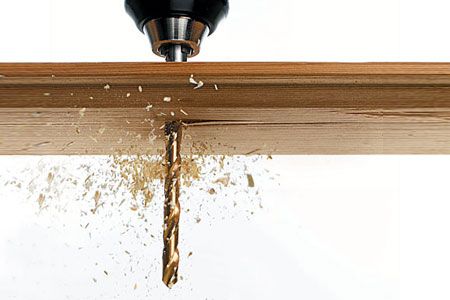Drill bits may not be the most exciting tools in your workshop, but they’re undoubtedly among the most important. These unassuming pieces of metal are the unsung heroes of countless do-it-yourself (DIY) projects and professional jobs.
From creating simple holes to complex boring tasks, drill bits come in various shapes and sizes, each designed for specific materials and applications. This comprehensive guide will explore the world of drill bits, their types and uses, and how to choose the right one for your project. It will familiarize you with different drill bits and help you optimize your projects for better quality and efficiency.
Versatile Workhorse Drill Bits
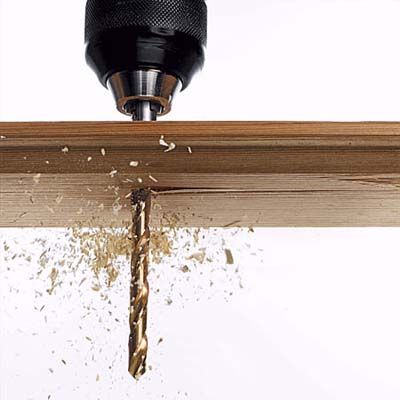
The twist bit is the jack-of-all-trades in the world of drill bits. This versatile tool can drill holes up to half an inch in diameter in a wide range of materials. The high-speed steel construction of these bits typically pairs with a titanium nitride coating, which offers multiple benefits.
First, the coating resists rust and reduces friction during use, allowing smoother drilling. Second, the coating helps the bit maintain its sharp edge longer than uncoated or black-oxide-coated steel bits. Due to their adaptability and reliability, twist bits are ideal for general-purpose drilling tasks.
When selecting a twist bit, consider the hole size you must create. These bits are typically available in sizes ranging from 1/16 to 1/2 inch, making them suitable for most common drilling tasks.
Brad Point (for Wood, Laminates, Plastic)
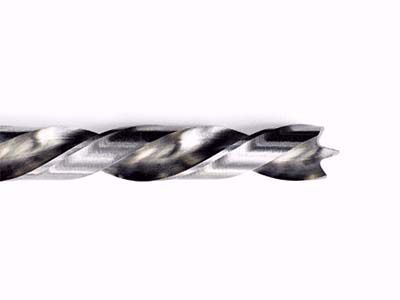
Brad point bits are excellent for precision wood, laminates, and plastic work. The defining feature of these bits is the sharp point at the tip, which acts as a guide to keep the bit centered as you begin drilling. This prevents the bit from wandering or skating across the surface, allowing for accurate hole placement. Brad point bits are indispensable for woodworkers because they create clean and precise holes.
High-quality brad point bits, like the one shown in the image, offer superior performance compared to standard versions. The chisel-edge tip of these premium bits bores its own pilot hole, resulting in faster and cleaner drilling. This feature is handy when working with hardwoods or when precision is necessary, such as in furniture making or cabinetry. The accurate results of brad point bits significantly reduce errors and improve the quality of finished projects.
Brad point bits are available in various sizes, typically ranging from 3/16 to 1/2 inch. While they may be more expensive than basic twist bits, the investment is often worthwhile for woodworkers and DIY enthusiasts who value clean, precise holes.
Available at woodcraft.com.
What a Bore
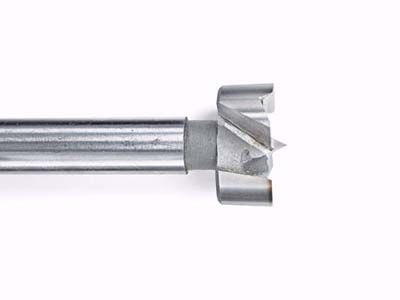
Forstner bits, often called “boring bits,” are a woodworker’s best friend when creating flat-bottomed holes with clean sides. When framing a deck, these specialized bits excel in applications such as mortising door hinges or recessing bolt heads. Their unique design allows them to bore holes with remarkable precision and cleanliness. Their versatility extends to complex woodworking techniques where standard bits would fall short.
Unlike twist bits or spade bits, Forstner bits cut around the hole’s perimeter, resulting in a smoother finish. They also excel at drilling angled or overlapping holes, making them invaluable for specific woodworking techniques. While they may require more pressure to use effectively, the results are often worth the extra effort. Many woodworkers prefer Forstner bits for their ability to deliver clean, professional results, even in intricate projects.
Forstner bits are available in various sizes, typically from 1/4 to 2 and 1/8 inches or larger. This variety allows woodworkers to tackle everything from small, precise work to larger boring tasks with a single type of bit. Their ability to handle multiple sizes and angles makes them versatile to any toolkit.
Available at Lee Valley.
Spade (for Wood)
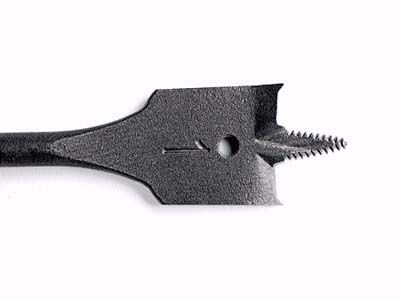
Spade bits, or paddle bits, are designed for quickly boring large holes in wood. They’re beneficial for creating rough-edged holes in framing for plumbing and electrical lines. Traditional spade bits often require constant pressure to maintain cutting action, which can be tiring for the user. However, spade bits remain a go-to option for many professionals due to their efficiency in drilling wide-diameter holes.
However, innovative designs like the one pictured have revolutionized spade bits. This particular bit features a threaded tip and angled spurs, allowing it to pull through the wood as you drill. This self-feeding action makes the drilling process much easier and faster, as you only need to control the drill’s trigger rather than applying constant pressure. These advancements have made spade bits more user-friendly and effective for large-scale drilling tasks.
Spade bits are typically available in sizes ranging from 1/4 inch to 1 and 1/2 inches, making them suitable for a wide range of hole sizes in wood. While they may not produce the cleanest holes, their speed and ease of use make them popular for rough construction work and other applications where finish quality is less important. Their practicality in creating quick, rough openings makes them indispensable for contractors and DIYers working on extensive framing projects.
Available at boschtools.com.
Cobalt Twist (for Stainless Steel, Cast Iron)
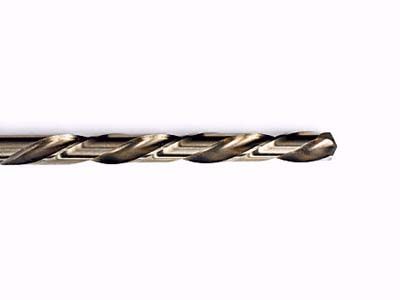
Cobalt twist bits are the go-to choice when drilling through rigid materials such as stainless steel or cast iron. While standard twist bits can handle mild steel and thin metals, these harder materials require a more robust solution. Cobalt bits consist of a high-speed steel alloy containing 5%–8% cobalt, which gives them superior hardness and heat resistance. Their resilience makes them the preferred option for industrial and heavy-duty applications.
The ability to dissipate heat efficiently is necessary when drilling into hard metals. During the drilling process, temperatures can reach up to 1,100 degrees Fahrenheit. The cobalt alloy in these bits allows them to maintain their cutting edge even under these extreme conditions, resulting in cleaner holes and longer bit life.
Cobalt twist bits are available in sizes ranging from 1/16 to 1/2 inch, covering most common drilling needs for tough metals. While they’re more expensive than standard high-speed steel bits, their durability and performance in demanding applications make them a worthwhile investment for professionals and serious do-it-yourselfers.
Available at craftsman.com.
Spear Point (for Glass or Tile)
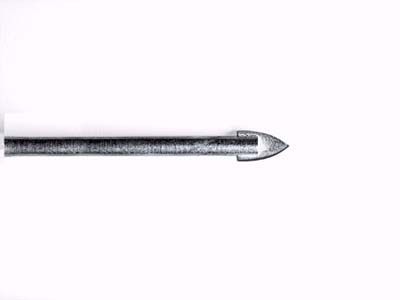
Drilling into glass or tile requires a specialized bit to prevent cracking or chipping. Spear point bits featuring a sharp carbide tip are great for these delicate materials. The bit’s unique shape allows it to score a clean, precise hole without putting excessive stress on the fragile surface. Spear point bits are necessary for projects involving bathroom or kitchen renovations.
It’s incredibly important to start slowly and carefully when using a spear point bit. Press the chucked bit against the surface until it creates a tiny divot. This initial mark helps prevent the bit from skittering across the smooth surface when drilling. Once you establish this starting point, begin drilling at a slow speed, gradually increasing as the hole progresses.
Spear point bits are typically available in sizes ranging from 1/8 to 1/2 inch. When working with glass or tile, it’s important to use plenty of water as a coolant to prevent overheating, which can cause the material to crack. With proper technique and patience, these bits can help you achieve professional-looking results in your tiling or glass projects.
Masonry (for Stone, Brick, Plaster, Metals)

Masonry bits are the workhorses of construction and renovation projects involving hard materials such as stone, brick, concrete, and some metals. Their defining feature is their carbide-tipped, winged design. The tungsten carbide tip is tough, allowing it to bore through hard materials effectively that would quickly dull standard bits. Masonry bits are indispensable for contractors and DIY enthusiasts working on extensive renovation projects.
The shaft of a masonry bit is typically made from durable spring steel, which provides the flexibility needed to withstand the shocks and vibrations encountered when drilling into hard, thick materials. This combination of a hard cutting tip and flexible shaft makes masonry bits ideal for a wide range of applications, from installing anchors in concrete to creating holes for wiring in brick walls.
Masonry bits are available in various sizes and are often sold in sets to cover different hole diameter needs. For best results, pair these bits with a hammer drill or rotary hammer, especially when working with solid materials such as concrete or stone. Their effectiveness in handling dense materials makes them a must-have for any serious construction or renovation toolkit.
Available at irwin.com.
Special-Purpose Bits
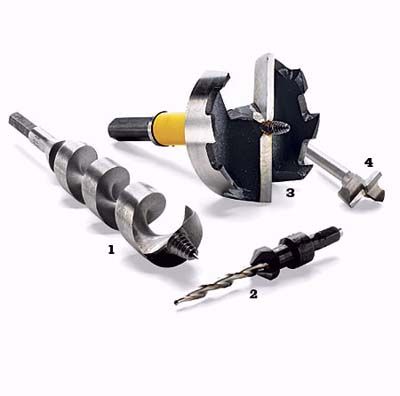
While standard drill bits can handle most everyday tasks, some require specialized tools. These special-purpose bits tackle specific challenges, offering unique features that make certain jobs easier, faster, or more precise. Understanding the benefits and applications of these bits can empower you to take on more complex projects with confidence and precision.
1. Ship Auger
Ship augers are designed for boring deep, clean holes and are handy for running pipes or wires through thick pieces of wood. The corkscrew shape of the bit, combined with a screw tip, pulls the bit through the wood as it cuts. This self-feeding action makes it easier to drill long, straight holes.
The single cutting edge of a ship auger is robust enough to slice through nails and staples, making it ideal for use in renovation projects where you may encounter hidden fasteners. The hollow center of the bit allows you to evacuate wood chips efficiently, preventing clogging and overheating during deep drilling operations.
Available at irwin.com.
2. Tapered
Tapered bits are perfect for creating the pilot holes for wood screws. The gradual taper of the bit matches the shape of a wood screw’s shank, creating a snug fit that maximizes the screw’s holding power. Many tapered bits also feature an integrated countersink, which creates a cone-shaped recess for the screw head, allowing it to sit flush with or below the wood surface.
An adjustable stop collar on these bits allows you to control the depth of the pilot hole and countersink, making it easy to achieve consistent results across multiple holes. This feature is particularly useful when working on projects that require a large number of screws, such as deck building or cabinet installation.
Available at wolfcraft.com.
3. Multi-spur
Multi-spur bits, also known as Forstner bits or sawtooth bits, are designed for creating large-diameter holes with flat bottoms and clean sides. These bits feature multiple cutting edges arranged in a circular pattern, aggressively shaving away wood as the bit rotates.
The design of multi-spur bits makes them ideal for tasks such as installing door locks, boring holes for large bolts, or creating pass-throughs for plumbing or electrical work in framing. Due to their large size and aggressive cutting action, these bits require a powerful drill, preferably a corded model or a high-voltage cordless drill with a side handle to manage the torque.
Available at dewalt.com.
4. Cornering
Cornering bits are specialized tools designed to create curved or angled holes, a nearly impossible task with standard straight bits. These bits feature multiple cutting surfaces along their length, allowing them to carve out material through the workpiece.
Start by using a cornering bit to drill straight into the wood at a medium speed. Once you’ve established a straight hole, slowly angle the drill to create the desired curve. The side cutters on the bit will remove the material as you change direction, allowing you to form complex paths for wiring, plumbing, or other applications where a straight hole won’t suffice.
Available at rockler.com.
A Better Way To Hold a Drill Bit

While a drill bit’s cutting edge is important, how the drill holds it can significantly impact its performance and ease of use. Traditional round-shank bits are common, but hex-shank bits offer several advantages, especially in high-torque situations. Hex-shank bits are increasingly popular because they provide a secure fit and withstand high-powered drilling tasks.
Hex-shank bits have a six-sided shaft that fits securely into the drill chuck’s jaws, preventing slippage during demanding drilling tasks. This secure grip helps transfer all the power from the drill efficiently to the bit’s cutting edge, resulting in cleaner holes and reduced wear on both the bit and the drill. Their reliable performance in high-torque settings makes them a preferred choice for many professionals.
Many modern drills come equipped with quick-change hex-shank adapters, which use retractable ball bearings to grip the bit at an indent in the shank. This system allows for rapid bit changes without manually adjusting the chuck. To change bits, simply pull back on the adapter to release the current bit, insert the new one, and push the adapter forward to reengage the ball bearings.
This quick-change system is particularly beneficial for projects that require frequent bit changes or when working in tight spaces where manipulating a chuck key might be difficult. While hex-shank bits are becoming increasingly popular, they may not be available in all sizes or types, so having a mix of hex and round-shank bits in your toolkit is good. Their flexibility and efficiency make them indispensable for a well-equipped workshop.
Our Conclusion
Drill bits may not be glamorous, but their importance in DIY and professional projects is apparent. There’s a perfect tool for every drilling task, from the versatile twist bit to specialized options such as spear point and cornering bits. Whether you’re a hobbyist or professional, mastering your drill bit selection can elevate the quality and efficiency of your work, making every project a success.
